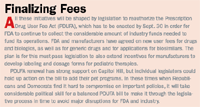New Year, New Issues
Pharmaceutical Executive
Look for action in 2012 on drug access, shortages, innovation, and transparency.
As the race heats up for the White House and control of Congress, industry will be keeping a sharp watch on how election-year politics affects health policy and drug regulation. A sign of the times is last month's move by HHS secretary Kathleen Sebelius to prevent the FDA from approving over-the-counter access for girls under the age of 17 to the morning-after pill, Teva's Plan B. That action reignited charges of the White House putting politics above science to keep a hot-button issue for conservatives off the table.

Jill Wechsler
The fate of pharmaceutical marketing under a reformed healthcare system hinges on political and legal developments in the coming months. Pharma backed Obamacare two years ago as a way to expand the market for prescription drugs. In return, industry agreed to pay hefty new fees, higher rebates on Medicaid drugs, and to subsidize the cost of drugs sold to seniors caught in the "donut hole" of the Medicare prescription drug program. Now manufacturers face a worst-case scenario: reform opponents kill the insurance exchanges and subsidies designed to expand enrollment, while retaining policies that cut pharma revenues and raise costs.
The 800-pound gorilla in the room is the looming Supreme Court decision on the constitutionality of the Obama health reform legislation. While the Justices ponder the weighty legal issues, HHS will continue to implement its multiple policies and programs, working with states to establish insurance exchanges and to expand IT systems and Medicaid programs. The administration's working assumption is that the Affordable Care Act (ACA)—or much of it—will remain in place.
Just as big a concern is that limited public and private resources will undercut efforts to advance biomedical research and expand public health programs. FDA received a slight increase in its 2012 budget, but barely enough to keep pace with expanded demands. One response from pharma is to continue to look overseas for less costly R&D and manufacturing opportunities, as well as new markets.
Cost-Cutting Pressures
The drive to cut healthcare spending will continue to shine the spotlight on pharmaceutical pricing, reimbursement, and access. New medicines will have to demonstrate value through marketer risk-sharing programs that skew prices to patient response to therapy. Tricky cost versus safety issues will arise, as with the debate over treatment of age-related macular degeneration with off-label use of inexpensive Avastin, instead of its more costly formulation Lucentis.
Pressure to cut costs will lead to an abbreviated pathway for bringing biosimilars to market. FDA guidance on the scope of preclinical and clinical testing needed to document product comparability and/or interchangeability will spur a land-grab rush in this field. Although several manufacturers have held meetings with FDA to discuss development strategies, biosimilar success will rest on decisions involving such thorny issues as product naming, coding, and the patent challenge process.
Biosimilars are a big issue because payers anticipate hefty savings from these look-alike therapies, as has been the case with small molecules over the past 25 years. Generic drugs now account for about 80 percent of prescriptions in the U.S., and the proportion will rise further as more blockbusters go off patent. However, Pfizer's move to retain a good portion of Lipitor sales by cutting its price and negotiating long-term deals with PBMs may have broad impact on the market and pharmacy programs—and keep the spotlight on brand/generic patent settlements that can delay when a generic comes to market.
Securing Supplies
The search for new pharma sources and new markets will further expand global drug production, with the relevant plusses and perils. The outcry over shortages of critical drugs is pressuring manufacturers to do more to secure supply chains. Proposed legislation could require added reporting to FDA on manufacturing problems, as well as tighter controls on drug imports, better track-and-trace systems, and stiffer penalties for counterfeiting and adulteration. FDA officials want pharma companies to police suppliers and distributors more closely and to establish back-up plans for dealing with production snafus.
Drug quality concerns will drive more frequent FDA inspections of manufacturing facilities and expanded FDA collaboration with regulatory counterparts in Europe and other regions to combine inspection resources and avoid redundant oversight. The agency also is looking to added user fees to support more inspections of foreign plants as a way to level the playing field between U.S. and foreign suppliers.
Pharma companies that violate manufacturing requirements, as well as policies against off-label marketing and illegal pricing, face intensified scrutiny from federal and state prosecutors. Many pharma companies have been hit with huge fines and onerous consent decrees for illegal activities, and things may get worse. Government officials keep threatening to penalize and jail individual corporate executives who fail to prevent violations, and some of the saber-rattling could escalate into real blows.
Spurring Innovation
The search for new drug development models to fill an admittedly dry pipeline will intensify with pharma's loss of revenues from blockbuster medicines. Public and private leaders of the biomedical research community talk more about "game-changing, transformational leaps" in discovery, as opposed to incremental gains. There is growing enthusiasm for developing "personalized" medicines—and relevant diagnostics—that provide more effective treatment based on individual genomic and metabolic characteristics.

Finalizing Fees
Public/private partnerships are supporting more international research on therapies for malaria, tuberculosis, and other diseases most prevalent in tropical climates. Health authorities are pressing for more R&D on new antibiotics, treatments for rare conditions, and therapies for killer diseases such as cancer and AIDS. There is growing excitement about vaccine discovery, which is attracting more industry investment as markets mature around the world.
The growth in overseas clinical research, though, will continue to raise concerns about unethical biomedical research practices. A White House panel has examined past U.S.-backed studies in Guatemala and proposed changes in current policy. That exercise may help shape a broader overhaul of rules and standards for all clinical studies sponsored by the federal government.
The drive for transparency, moreover, will spur more efforts to expand disclosure of active trials and study results on the Clinicaltrials.gov website. And FDA and the NIH are strengthening financial conflict-of-interest policies to address perennial concerns that economic interests could compromise research results.
Health reform "Sunshine" provisions, which HHS finally unveiled last month, will require pharma marketers to disclose payments to physicians, raising fears that physicians will be discouraged further from participating in clinical research, as well as pharma marketing programs. Despite these concerns, assurance that biomedical research practices fully protect patients and provide valid clinical data is critical to building public confidence in the R&D process.
"Patient centeredness" will shape a range of regulatory and research initiatives. FDA is encouraging sponsors to incorporate patient needs and viewpoints into clinical trial protocol design, patient recruitment, and safety evaluation. This approach will be supported by research sponsored by the Patient-Centered Outcomes Research Institute (PCORI), which is slated to have a $500 million annual budget by 2014 to study effective treatments for important conditions. PCORI plans to finalize priorities for its research agenda by March, and its Methodologies Committee aims to report in May on research methods and standards for this field.
FDA commissioner Margaret Hamburg will continue to seek support for regulatory science initiatives that can accelerate the R&D process. She points to multiple biomarker validation projects that can identify potential drug safety problems early on and reduce trial failures. Coalitions are looking to streamline clinical studies with "adaptive" clinical trials and electronic methods for recruiting patients and collecting research data.
Despite these initiatives, pharma and biotech companies complain that a risk-averse tendency at FDA keeps promising medicines off the market. Agency officials, though, point to last year's jump in approvals for important new drugs as evidence of its flexibility. FDA promises to do more to assist emerging companies navigate the regulatory process, but it remains to be seen if the recent spike in approvals is a fluke, or a signal of real progress on the innovation front.
Jill Wechsler is Pharmaceutical Executive's Washington correspondent. She can be reached at jwechsler@advanstar.com

Navigating Distrust: Pharma in the Age of Social Media
February 18th 2025Ian Baer, Founder and CEO of Sooth, discusses how the growing distrust in social media will impact industry marketing strategies and the relationships between pharmaceutical companies and the patients they aim to serve. He also explains dark social, how to combat misinformation, closing the trust gap, and more.
Is Artificial Intelligence a ‘Product’? Products Liability Implications for AI-Based Products
April 10th 2025As the physical products we use evolve to become increasingly complex, traditional products liability frameworks may not always fit to provide remedies for harm that can result from using novel product types.
FDA Approves Opdivo Plus Yervoy Regimen for MSI-H/dMMR Colorectal Cancer
April 9th 2025Approval of the Opdivo plus Yervoy combination regimen was based on results from the Phase III CheckMate-8HW trial, which was the largest immunotherapy study in patients with previously untreated, unresectable, or metastatic microsatellite instability-high or mismatch repair deficient colorectal cancer.